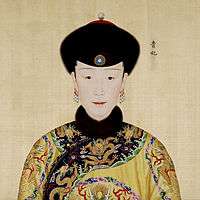Imperial Noble Consort Huixian
Imperial Noble Consort Huixian (1711 – 25 February 1745), of the Manchu Bordered Yellow Banner Gaogiya clan, was a consort of the Qianlong Emperor.
| Imperial Noble Consort Huixian | |||||
|---|---|---|---|---|---|
 | |||||
| Born | 1711 (康熙五十年) | ||||
| Died | 25 February 1745 (aged 33–34) (乾隆十年 正月 二十五日) Forbidden City | ||||
| Burial | Yu Mausoleum, Eastern Qing tombs | ||||
| Spouse | |||||
| |||||
| House | Gao, later Gaogiya (高佳; by birth) Aisin Gioro (by marriage) | ||||
| Imperial Noble Consort Huixian | |||||||
|---|---|---|---|---|---|---|---|
| Traditional Chinese | 慧賢皇貴妃 | ||||||
| Simplified Chinese | 慧贤皇贵妃 | ||||||
| |||||||
Life
Family background
Imperial Noble Consort Huixian's personal name was not recorded in history. She was a Han Chinese Booi Aha by birth.
- Father: Gao Bin (高斌; 1683–1755), served as the Minister of Personnel from 1745–1747 and a Grand Secretary in the Wenyuan Library from 1747–1748
- Paternal grandfather: Yanzhong (衍中)
- Paternal grandmother: Lady Li
- Mother: Lady Chen
- One younger brother
- Three younger sisters
Yongzheng era
It is not known when Lady Gao become a lady-in-waiting, and then mistress, of Hongli, the fourth son of the Yongzheng Emperor. On 4 April 1734, she was elevated to his secondary consort.
Qianlong era
The Yongzheng Emperor died on 8 October 1735 and was succeeded by Hongli, who was enthroned as the Qianlong Emperor. Around the time, Gao Bin wrote a memorial to the Yongzheng Emperor, thanking him for a bunch of lychees, but it was too late as the emperor had already died when the memorial reached the palace, so the Qianlong Emperor replied in place of his father:
My father recognised your talent and promoted you to a high position. You should do your utmost to repay his grace. Even though your daughter is waiting on me, you should not be harbouring any ill intentions. This will not be tolerated by national law. If you serve the nation well with sincerity and integrity, I will not refrain from giving rewards to avoid being criticised for showing favouritism.[1]
On 23 January 1738, Lady Gao was granted the title "Noble Consort". As she was the only woman in the imperial harem holding the rank of Noble Consort at the time, she did not receive any special title to distinguish her from the emperor's other consorts.
On 23 February 1745, when Lady Gao became critically ill, she was elevated to "Imperial Noble Consort" by the Qianlong Emperor. However, she never managed to attend the promotion ceremony because she died two days after the emperor announced his decision. In 1752, she was interred in the Yu Mausoleum of the Eastern Qing tombs.
Titles
- During the reign of the Kangxi Emperor (r. 1661–1722):
- Lady Gao (from 1711)
- During the reign of the Yongzheng Emperor (r. 1722–1735):
- Mistress
- Secondary consort (側福晉; from 4 April 1734[2])
- During the reign of the Qianlong Emperor (r. 1735–1796):
In fiction and popular culture
- Portrayed by Fu Chong in Jiangshan Weizhong (2002)
- Portrayed by Tan Zhuo in Story of Yanxi Palace (2018)
- Portrayed by Tong Yao in Ruyi's Royal Love in the Palace (2018)
See also
- Ranks of imperial consorts in China#Qing
- Royal and noble ranks of the Qing dynasty
Notes
- Ho & Bronson (2004).
- 雍正十二年 三月 一日
- 乾隆二年 十二月 四日
- 乾隆十年 正月 二十三日
- 乾隆十年 正月 二十六日
References
- Ho, Chuimei; Bronson, Bennet (2004). Splendors of China's Forbidden City: The Glorious Reign of Emperor Qianlong (Illustrated ed.). Merrell. ISBN 1858942039.
- Rawski, Evelyn S.; Rawson, Jessica (2006). China: The Three Emperors 1662-1795. Harry N. Abrams. ISBN 1903973694.
- Wan, Yi; Shuqing, Wang; Yanzhen, Lu; Scott, Rosemary E. (1988). Daily Life in the Forbidden City: The Qing Dynasty, 1644-1912 (Illustrated ed.). Viking. ISBN 0670811645.
- Zhao, Erxun (1928). Draft History of Qing (Qing Shi Gao) (in Chinese).